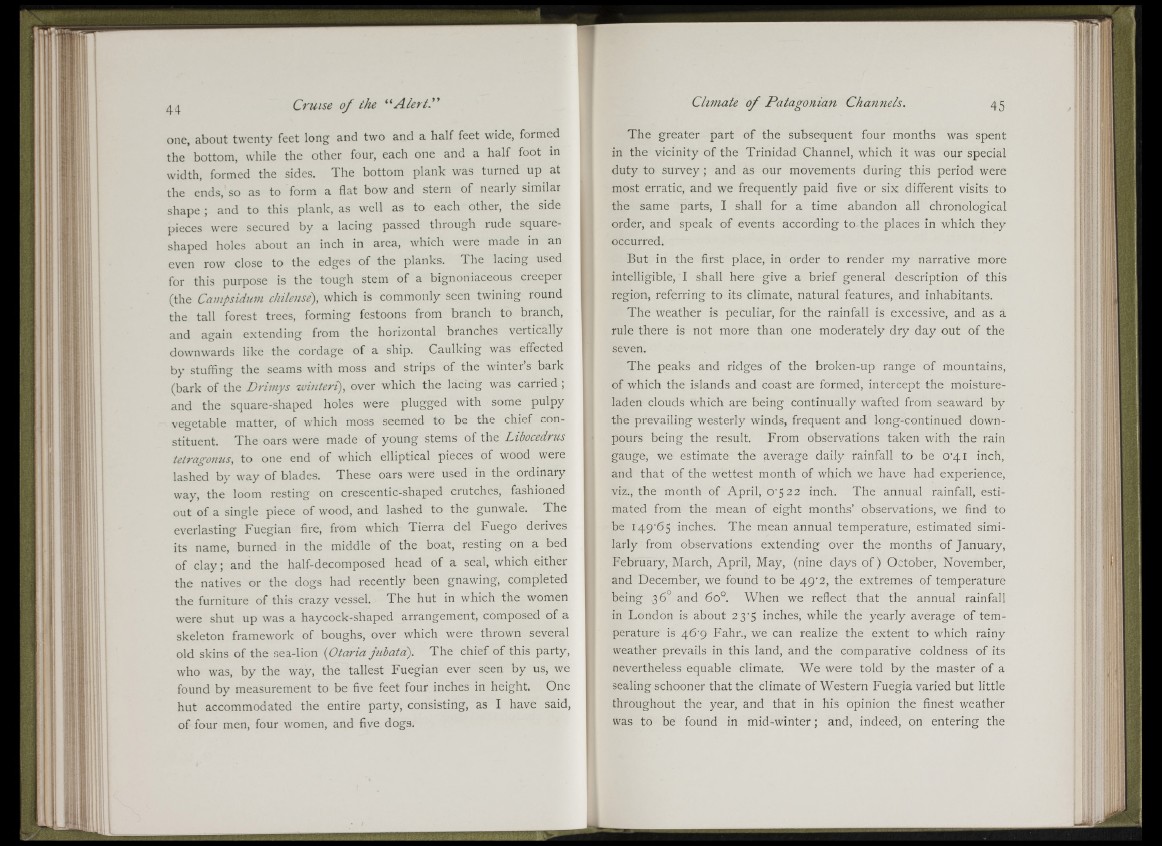
I Ili
Cruise o f the “ Alert.”
one, about twenty feet long and two and a half feet wide, formed
the bottom, while the other four, each one and a half foot in
width, formed the sides. The bottom plank was turned up at
the ends,'so as to form a flat bow and stern of neaily similar
shape ; and to this plank, as well as to each other, the side
pieces were secured by a lacing passed through rude squareshaped
holes about an inch in area, Avhich were made in an
even row close to the edges of the planks. The lacing used
for this purpose is the tough stem of a bignoniaceous creeper
(the Cmnpsidum chilense), which is commonly seen twining round
the tall forest trees, forming festoons from branch to branch,
and again extending from the horizontal branches vertically
downwards like the cordage of a ship. Caulking was effected
by stuffing the seams with moss and strips of the winter’s bark
(bark of the Driviys winteri), over which the lacing was carried ;
and the square-shaped holes were plugged with some pulpy
vegetable matter, of which moss seemed to be the chief constituent.
The oars were made of young stems of the Libocedrus
tetragonus, to one end of which elliptical pieces of wood were
lashed by way of blades. These oars were used in the ordinary
way, the loom resting on crescentic-shaped crutches, fashioned
out of a single piece of wood, and lashed to the gunwale. The
everlasting Fuegian fire, from which Tierra del Fuego derives
its name, burned in the middle of the boat, resting on a bed
of clay; and the half-decomposed head of a seal, which either
the natives or the dogs had recently been gnawing, completed
the furniture of this crazy vessel. The hut in which the women
were shut up was a haycock-shaped arrangement, composed of a
skeleton framework of boughs, over which were thrown several
old skins of the sea-lion {Otaria jubatd). The chief of this party,
who was, by the way, the tallest Fuegian ever seen by us, we
found by measurement to be five feet four inches in height. One
hut accommodated the entire party, consisting, as I have said,
of four men, four women, and five dogs.
Climate o f Patagonian Channels. 45
The greater part of the subsequent four months was spent
in the vicinity of the Trinidad Channel, which it was our special
dut)' to survey ; and as our movements during this period were
most erratic, and we frequently paid five or six different visits to
the same parts, I shall for a time abandon all chronological
order, and speak of events according to the places in which they
occurred.
But in the first place, in order to render my narrative more
intelligible,'! shall here give a brief general description of this
region, referring to its climate, natural features, and inhabitants.
The weather is peculiar, for the rainfall is excessive, and as a
rule there is not more than one moderately dry day out of the
seven.
The peaks and ridges of the broken-up range of mountains,
of which the islands and coast are formed, intercept the moistureladen
clouds which are being continually wafted from seaward by
the prevailing westerly winds, frequent and long-continued downpours
being the result. From observations taken with the rain
gauge, we estimate the average daily rainfall to be O 'q i inch,
and that of the wettest month of which we have had experience,
viz., the month of April, o'5 22 inch. The annual rainfall, estimated
from the mean of eight months’ observations, we find to
be I49’65 inches. The mean annual temperature, estimated similarly
from observations extending over the months of January,
February, March, April, May, (nine days of) October, November,
and December, we found to be 49’2, the extremes of temperature
being 36° and 60°. When we reflect that the annual rainfall
in Fondon is about 23'5 inches, while the yearly average of temperature
is 46 9 Fahr., we can realize the extent to which rainy
weather prevails in this land, and the comparative coldness of its
nevertheless equable climate. We were told by the master of a
sealing schooner that the climate of Western Fuegia varied but little
throughout the year, and that in his opinion the finest weather
was to be found in mid-winter ; and, indeed, on entering the
I K ! Ill
i : ^
H r I
I
I